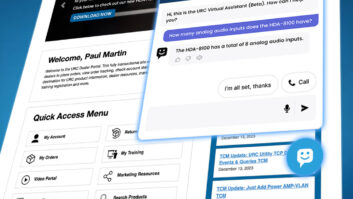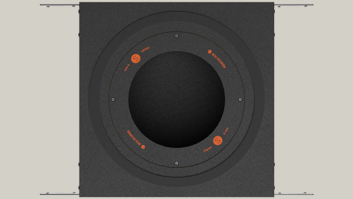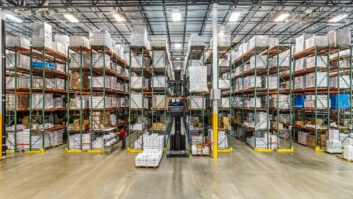There was a time a few years ago when it seemed like the business boom would last forever. The referrals would flow in and “budget” would never be an issue with a client.
It’s no secret that times have changed. The dot-com bubble burst and Wall Street is not the sure thing that it once seemed to be. The rich are still rich, but the neo-rich have disappeared and much of the disposable income that fuels the custom installation market has dried up.
For the leading companies in the industry, however, this news is not all doom and gloom. To them, times are simply different and business approaches are changing as a result.
Based on answers from a recent RS survey of some the industry’s top dealers and integrators, important insight can be gained on how to run a custom installation business during challenging economic times. Because no region of the country faces exactly the same set of obstacles or opportunities as the other, dealers quoted in this article were chosen, in part, to represent specific markets.
Based on the “thumbnail sketches” provided by the RS Mid-Year Report survey, leading custom dealers appear to bouncing back quite well both from a market correction following the dot-com bust as well as the tragedy of 9/11. Several respondents projected a relatively “flat” year in revenue in 2002. However, many more have experienced growth during the past six to eight months. Not surprising, the biggest drop in business in the past two years for most respondents, occurred following the terrorist attacks on 9/11. But that often overshadows the longer-lasting effects felt in many markets after the dot-com bust. “I think what’s gone away, at least for us, is the crazy stuff–the guys who got rich on the IPO in the ’90s,” said Audio Advices Leon Shaw in Raleigh/Durham. “We’re not installing the $600,000 theater package anymore.”
However, Shaw sees the rest of the year appearing to be “pretty good” despite a slow down in ultra-high-end housing starts in his market. “We haven’t gotten a bunch of huge houses signed for 2003 yet,” he said. “They’re starting to pop in now but we went through a little lull there and now they’re starting to come back.”
Mark Hoffenberg of AudioVisions in Lake Forest, California, tells a similar tale. “Two years ago everyone in our industry was riding the dot-com wave,” he said. “Clients were flush with paper money from the stock market and planning like there was no tomorrow. Well, tomorrow came and the paper money dried up. However, in our market niche I do not see this as a recession but as a market correction.”
Hoffenberg said that his company’s “tried-and-true high-end client base” has actually increased in sales during this correction, and although much more cautious, they are still buying while the economy is soft.
In the Boston area, Media Systems’ Mitchell Klein expects to have a “flat” year over last year. “We would actually be very happy with that,” he said. We have always maintained a “controlled-growth” approach to building our business, managing a 20 percent increase in sales in each of the past two years. Our interest lies in building an organization that can maintain strict quality and customer service standards; we are not interested in just getting bigger for the sake of volume.”
Justifiably dealers feared the worst for their businesses as the country recovered after the 9/11 attacks. However, most adjusted accordingly and have landed solidly on their feet. “From our perspective, people went into a buying freeze for several months after September 11,” said Sean Fields of Audio/Video Entertainment (AVE) in Laguna Niguel, California. “We experienced the same setbacks as I suspect most companies in the custom installation field suffered, but presently the second quarter of 2002 has been our best quarter ever, and the rest of 2002 looks to be another record-breaking year for us.” Bill Skaer’s business at Eric Grundelman in Mesquite, Texas, is ahead of last year by about eight percent, because, he said, his company has been proactive and is working harder for their business. “We were lucky in that many of our peers had a decline in business after 9/11,” he said. “Ours was slower, but we had enough momentum going that we didn’t feel it like we might have otherwise.”
For James Montgomery of Amenitytech in Baltimore, Maryland, the biggest post-9/11 change in types of products his clients are requesting. “People know they want to be secure, safe and to control their worlds,S he said. As a result, they have focused on services and products that are a natural lead-in for the best of what we have to offer as integrators.”
Elizabeth O’Keefe of the The Screening Room in St. Louis, Missouri, said that since September, her company’s business has been virtually unaffected, possibly due to the “cocooning” effect, which been a boon to business. “Perhaps it is because so many of our clients want to spend good quality time at home with their families,S she said.
Not surprisingly, however, are the difficulties still facing dealers in the New York City area, such as JetPak Electric’s Todd Rosencrans. “New York City is still distressed over the terrorist attack that hit my clients squarely in the gut,” he said. “That has put many of them in a less aggressive frame of mind in embellishing their Manhattan homes. Perhaps even more important as a cause for less lavish discretionary spending is a general collapse in confidence of clients in the value of their assets. The Enron scam, the Andersen involvement in it, as well as the Tyco and Global Crossings ruptures have all led to a serious questioning of the true value of market holdings. Simply put, while my clients are certainly not hurting, they just don’t know their true financial value.”
Leif Pherson of Los Angeles-based Roberts Home Audio & Video, also has experienced the adverse effects of Wall Street fluctuations. “The Market is definitely having a dampening effect on our business and we’re probably break-even versus last year, as a result,” he said.
As a result of having clients put projects on hold after 9/11 and seeing others simply cutting back, Advanced Audio Design’s Andrew Guenther in Sarasota, Florida, has begun to change his business strategy. “We have reviewed the way we do things and are being proactive in developing new ways to build up sales volume,” he said.
Among the many survey respondents who said that their businesses were bouncing back from 2001 drop-offs is former CEDIA president Steve Hayes of Custom Electronics in Falmouth, Maine. “Our volume is up slightly (15 percent) from last year’s numbers and about even with two years ago,” he said. “I am actually encouraged by what we have been seeing over the past two months. We have been closing new contracts at about a $4-million run rate lately, so I am more hopeful than in the past. I believe this might be a good growth year for us if we watch the business closely.”
While dealers like Sean Fields in California and Bob Borick’s Performance Hi-Fidelity in Kingston, Pennsylvania, are witnessing continued new home construction in their markets, others like Darren Hicks of Aspen Automated Lifestyles in Bountiful, Utah, are still feeling the effects of the same setbacks felt by Salt Lake City custom builders, architects and designers before and during this past winter’s Olympic Games.
“Most of the custom builders we worked with stopped working and left town for the Olympics,” he said. “Three of the custom builders we have worked with have been uncharacteristically flat this year.S
Sean Fields is no stranger to working with the builder community. Right after the 9/11 attacks, Fields’ company went on the offensive to offset possible market setbacks. “It’s been my experience that the worse the economic times, the more that marketing is needed. If for nothing else, it places you in a better position when the economy begins its recovery,” he said. “My first move in late September 2001, was to expand our sales to other builders. Because our business is closely tied to the building industry I wanted to expand our customer base–to spread it around, as it were. I have not had the chance to meet with some of the larger builders in our area before, and the bleak future actually served to give me the kick in the pants to finally do it.”
Some dealers, like JetPak Electric’s Rosencrans, are also battling with slow-paying clients who are “getting nervous about the economy,” and are being forced to adapt to changing times. “I have been spoiled in not really having to look for projects or new avenues of work,” he said. “I am now reaching out to general contractors and builders in my niche and region that I had not previously approached. This will eat into my already precious time as I build new relationships and research these new companies’ histories and reputations.”
For many dealers in the RS survey, the size of projects has increased in recent months. Some, such as Bob Borick, attribute this change to the cocooning effect. Others, such as Bob Gullo, believe that projects under $25,000 have vanished because of the struggling economy. For some, like James Montgomery, the ripple effect of 9/11 has generated more interest in automation, observation and security.
On another topic, most respondents said that vendor/dealer relationships remain mutually beneficial,S with manufacturers, as a whole, appearing to be much more cognizant and carefulS with payment terms. However, several said that their vendors are much less forgiving.
Some vendors press us hard for sales increases while keeping credit lines too small to support their own sales projections,S Klein said. Other relations are strained as we put more and more energy into expediting products that are backordered or discontinued with replacement models not yet available. It seems insane how much back office effort must be afforded just to get product shipped!S
Ray Lepper, CEDIA’s vice president and president of Home Media in Midlothian, Virginia, agrees that vendor/dealer relations are a mixed bag. The smaller vendors are doing a great job,S he said. The large vendors are acting like blind-drunks in a walk in-closet.S
Andrew Guenther views the same issue with fewer shades of gray. I see a scary trend happening in regard to venders,S he said. It seems that the sales volume is not high enough for them. I see them taking on a lot of under-qualified, under-experienced (trunk slammers) that tend to give things away. This cuts into our business in two ways: It costs us a job we may otherwise have had, and it lowers the quantity that we the dealer that has spent years building the brand name and awareness of there product.S
Retail, in general, is becoming less and less attractive for most custom installers interviewed, although one or two dealers are holding firm to that part of their business.
“We have deliberately de-emphasized our retail operation since January of this year,” Lepper said. “We love it! We’re spending more time, and doing more business, with fewer customers. Less is more!”
Steve Hayes agreed. We have a small retail operation, and we believe that retail is dead…totally and helplessly, dead,” he said. “We are working to try to reinvent that show-floor space in some way.”
Audio Advice’s Leon Shaw said that his company’s retail business is actually beginning to pick up as a result of infrastructure changes. “Two-channel retail is our background, and that’s coming back well now that our new showroom is built.”
The Screening Room’s Elizabeth O’Keefe isn’t turning her back on retail either, having recently opened a new retail showroom. “It is designed like a fully automated home, with over six dedicated theaters throughout for displaying different tastes in theme dcor and equipment selection,” she said. “Ask me how we’re doing in a year, but today we’re doing great!”
In general, dealers such as AudioVisions’ Hoffenberg and Custom Electronics’ Hayes aren’t struggling with business, but have found it necessary to adapt their businesses in the face of other impending factors. “One of our primary challenges is growing our company to the next plateau,” Hoffenberg said. “We are at a very important growth phase that is forcing us to re-think all of our business practices, build a platform for the next 10 years and push ourselves beyond who we are today.” Some of Hoffenberg’s adjustments have centered on hiring a full-time CFO that pays close attention to his company’s bottom line, restructuring his organization and “org chart” to make it more scalable for the future and more efficient for today, and developing detailed processes and procedures for installation and control system programming.”
Hayes points to his company’s efforts to counter the growing threat of eroding product sales margins from increasing Internet sales. “We believe it will only get worse, so we have significantly boosted our focus with clients to talk about and charge for our services as separate line items,” he said. “Design, pre-kit, documentation, owners manuals, training, service agreements, engineering, burn-in, etc., all show as line items in our proposals. We are also being more aggressive about pursuing time and material contracts. It’s always fun to be able to charge for every minute you work on a project. We have also purchased and are converting to a fully integrated operations software, changing our computer structure to include a VPN for work-at-home options and cutting out the frills for now.”
Other dealers are getting creative with their business approach, as well. Jeff Hoover, president of CEDIA and Audio Advisors in West Palm Beach, Florida, has diversified his offerings to cabinetry, furnishing, etc., so much that his company now earns about 30 percent of its gross revenues outside the scope of A/V and integration.
Audio Advice’s Shaw has directed his sales staff to “get on the phone more,” to contact their 11,000 active customers, and has become more consistent about sending out a company newsletter to his customers. “I started doing that every three months instead of every six,” he said.
Roberts’s Leif Pherson is also taking a more personal approach to sales leads and is advertising for the first time in select publications geared at architects, designers, and the “Fortune 1500” market. “We are ultimately seeking to distance ourselves from the every-day installer,” he said.
Similarly, others such as Bob Borick of Performance Hi-Fidelity, have placed more emphasis on marketing and public relations efforts. “We have made a concerted effort to be more involved with the local Professional Builders Association to make other members aware of what we do and how we can work together,” Borick said. “In a smaller market like ours the more trade relationships we have and contacts we make, plus advertising directly to the consumer via direct full color catalogs etc. has produced some continual avenues of future business for us.”
Aspen Automated’s Darren Hicks actually began refocusing his company’s marketing two years ago. “The most significant changes include making a written marketing plan including a budget, introducing a small amount of end-user image advertising, and implementing a formal builder incentive program which provides steady and consistent contact and reward to those who bring Aspen business.
Electronic Design Group’s Bob Gullo said that he does not subscribe to the theory that a company doesn’t need to market itself. “Our marketing and PR is exactly as it always has been–highly budgeted and strong,” he said. “I take marketing very seriously, because it helps re-fuel the referral machine that we all love.”
Ray Lepper concurs. “We’ve been working harder on PR than on advertising,” he said. “We’ve also been tightening up our branding and our image, trying to make sure all that all of the messages we send–from showroom, to paperwork, to presentations, to dialogs with clients–feel very consistent and comfortable for our target customers.S
Within the past year, Mitchell Klein made a formalized commitment to marketing his business by hiring a dedicated person to manage it. Her efforts have included outreach programs to professional trades and increased direct communication with current clients,S he said. She has also arranged photo shoots, press releases, collateral materials, use of coop and other available marketing funds. This separation of responsibilities allows others in our organization, who were previously juggling this effort, to focus on other areas of the business.S
Additionally, Kleins company is offering ongoing CEU training to the architectural and design trade. They plan monthly events in conjunction with the Boston Design Center and have re-established their newsletter, which maintains communication with all our contacts.
Sean Fields said that he hasnt changed his strategy as much as expand upon a long-term plan we set in motion several years ago. Our end-goal is to make the idea of integrated home entertainment and information systems less exotic in the minds of our clients,S he said. We want people to see integrated systems as a natural part of the home’s infrastructure, comparable with plumbing and electrical.S
AVE produces printed and Internet material designed to demystify integrated systems. The company also has launched a website that’s as client-friendly as it can be. It goes a long way toward answering client questions, so that when they call us, the client has a knowledge base, and we can move forward into the details quicker,S Fields said.
Perhaps most straightforward of all, AudioVisions Mark Hoffenberg has refocused his marketing efforts simply on custom satisfaction. A happy client will bring you more business,S he explained. We are very committed to setting proper expectations during the sales process, delivering systems that work, installing them in a timely manner and following up with clients to insure repeat business.S
Jeremy J. Glowacki is editor of Residential Systems.







